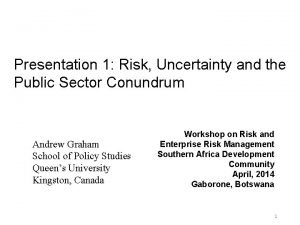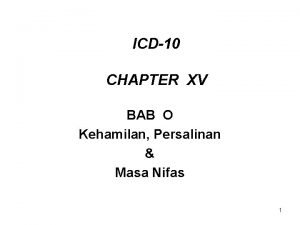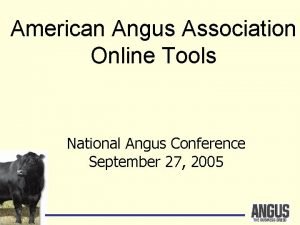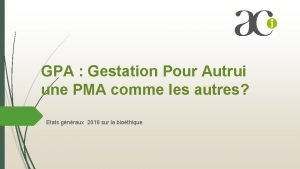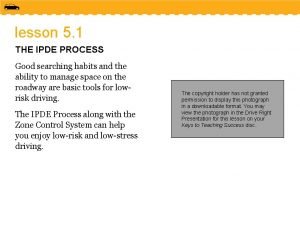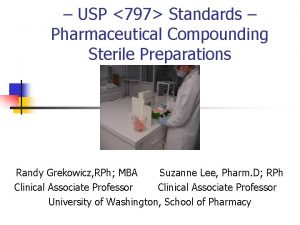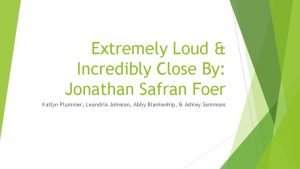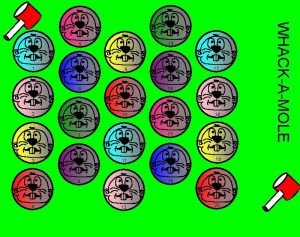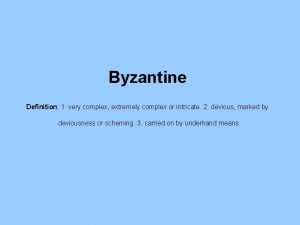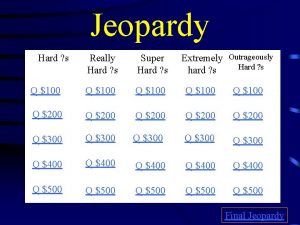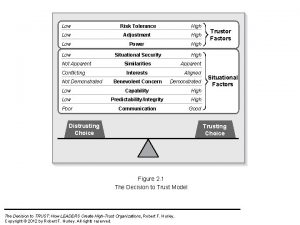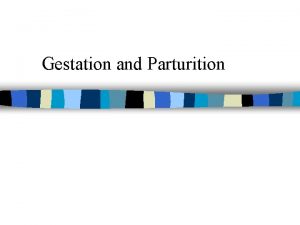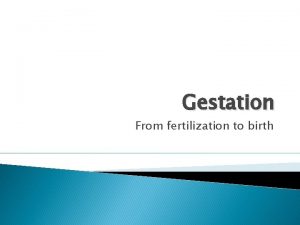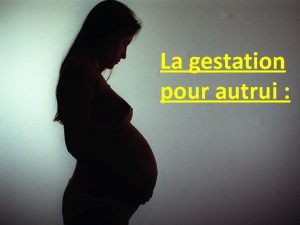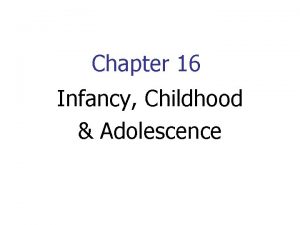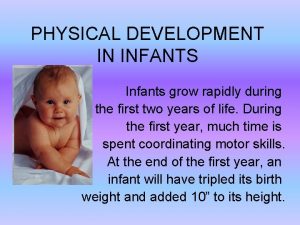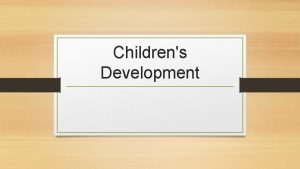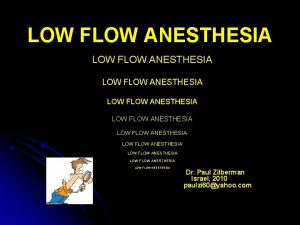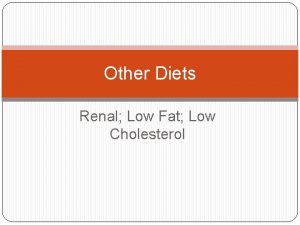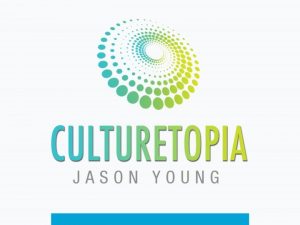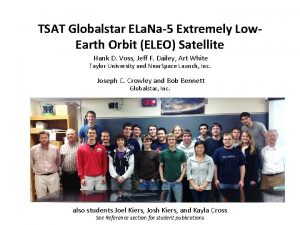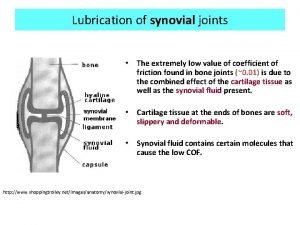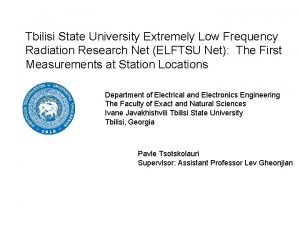Extremely low gestation infants are at high risk





















- Slides: 21

Extremely low gestation infants are at high risk for auditory neuropathy Lynn M. Iwamoto, MD; Konstantine Xoinis, MD; Yusnita Weirather, MA, CCC-A; Hareesh Mavoori, Ph. D; Steven Shaha, Ph. D Kapiolani Medical Center for Women & Children, Hawaii Pacific Health Center for Health Outcomes Honolulu, Hawaii

Faculty Disclosure Information • In the past 12 months, I have not had a significant financial interest or other relationship with the manufacturer(s) of the product(s) or provider(s) of the service(s) that will be discussed in my presentation. • This presentation will not include discussion of pharmaceuticals or devices that have not been approved by the FDA.

Auditory Neuropathy Auditory dys-synchrony (AD) n Transmission of sound to the brain is abnormal n Abnormal brainstem evoked responses (ABR) n Normal acoustic emissions (OAE) n Preserved cochlear microphonics n Acoustic reflex absent n n May be missed with OAE screening

Auditory Neuropathy n Pathophysiology Cochlear inner hair cells n Neural pathways: CN VIII n Brainstem n n Speech perception is impaired Fluctuating losses n Difficulty in background noise n n Prognosis is unpredictable n Optimum management is unclear

High risk neonates Sensorineural hearing loss is 10 times more prevalent n Auditory neuropathy (AN) n n Rance, et al 1999 n 1991 -1996 n 5199 infants screened (at risk population) n 2. 3/1000 AN n 11% of 109 SNHL n Berg, et al 2005 n Mar 2002 -Dec 2003 n 24. 1% of 432 NICU (regional perinatal center)

Risk Factors Family history n Prematurity n Hyperbilirubinemia n Ototoxic medications n Hypoxia n Hydrocephalus n Meningitis n

Objectives n Establish prevalence rate for auditory neuropathy in the high risk nursery n Differentiate infants with auditory neuropathy from those with cochlear hearing loss

Patient Population n Retrospective review 1999 -2003 n Kapiolani Medical Center for Women and Children Newborn Special Care Unit n n Sensorineural hearing loss n n Auditory neuropathy Gestational age-matched controls

Data Collected Demographics n n n Gestational age Birthweight Gender Ethnicity Apgar scores Severity of illness n n Length of hospitalization Chronic lung disease Intraventricular hemorrhage Necrotizing enterocolitis

Data Collected Risk Factors n Medications Furosemide n Aminoglycosides n Vancomycin n Dexamethasone n n Infections CMV n Toxoplasmosis n Meningitis n

Data Collected Risk Factors n Mechanical ventilation Conventional ventilation n High frequency ventilation n Hyperbilirubinemia n Pulmonary hypertension n n Nitric oxide

AN vs SNHL vs Control AN/AD SNHL Control (24) (71) (92) 28± 5† 33± 5 32± 5 1318± 894† 1968± 1006 1872± 996 58 61 53 1 min apgar 4. 8± 2. 5 6. 1± 2. 2 5. 6± 2. 3 5 min apgar 6. 7± 1. 6 7. 7± 1. 7 7. 3± 1. 7 117± 76*† 73± 89* 40± 62 Gestational age (wks) Birthweight (g) Male gender (%) Length of hospitalization (d) *p<0. 05 vs. Control †p<0. 05 vs. SNHL

Gestational Age Distribution High Risk Nursery 1999 -2003

PREVALENCE By Gestational Age Group

Exposure to Medications AN/AD SNHL Control (%) (%) Aminoglycosides 95. 8* 80. 3 70. 7 Furosemide 95. 8†* 50. 7* 32. 6 Vancomycin 79. 2†* 41. 4 27. 2 Dexamethasone 54. 2* 32. 4* 14. 1 *p<0. 05 vs control † p< 0. 05 vs SNHL

Neonatal Morbidities Peak Bilirubin (mg/dl) Ventilation (d) HFOV (%) CMV Infection (%) *p<0. 05 vs Control AN/AD SNHL Control 12. 7± 4. 2 13. 1± 6. 3* 10. 0± 3. 5 45± 42* 28± 31 19± 29 16. 7 28. 2* 8. 7 0 7. 0* 0

Neonatal Morbidities AN/AD SNHL Control (%) (%) BPD 66. 7†* 30. 0* 23. 9 IVH 16. 7 9. 9 3. 3 Hydrocephalus 4. 2 8. 5 3. 3 NEC 8. 3 8. 5 3. 3 * p<0. 05 vs. control † p < 0. 05 vs. SNHL

Summary n SNHL = 21/1000 in the NICU n AN/AD = 5. 3/1000 26% of hearing loss n 2/3 were ≤ 28 wks gestation n 44% of hearing loss for those ≤ 28 wks n

Summary n AN/AD vs. SNHL Younger gestation n Lower birthweight n Greater exposure to potential ototoxic medications n n Furosemide n Vancomycin Higher incidence of BPD n Longer hospitalization n

Conclusions n Auditory neuropathy is a significant problem in the high risk nursery population. n Extremely premature infants are at highest risk.

Perspective n Infants in the high risk nursery should be routinely screened by both ABR and OAE before hospital discharge. n Early identification of AN/AD will lead to a better understanding of the pathophysiology and the development of appropriate intervention strategies.
 Antigentest åre
Antigentest åre Mid = low + (high - low) / 2
Mid = low + (high - low) / 2 High risk low probability
High risk low probability Chianina blade steak
Chianina blade steak Icd 10 kehamilan kembar
Icd 10 kehamilan kembar American angus login
American angus login Grossesse berger allemand
Grossesse berger allemand Mère porteuse
Mère porteuse Market risk credit risk operational risk
Market risk credit risk operational risk High risk high return artinya
High risk high return artinya Emotive communication style
Emotive communication style High precision vs high accuracy
High precision vs high accuracy Low voltage = low hazard
Low voltage = low hazard The ipde method of driving represents
The ipde method of driving represents Usp 797 laminar flow hood cleaning
Usp 797 laminar flow hood cleaning Hrllp
Hrllp Only in extremely dangerous situations
Only in extremely dangerous situations Natural selection will ultimately make a species
Natural selection will ultimately make a species Contains graphic content
Contains graphic content Byzantine definition
Byzantine definition Extremely
Extremely Extremely
Extremely


